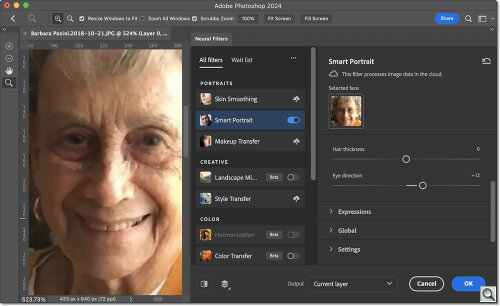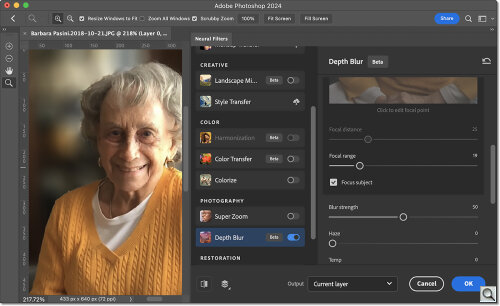Photo Corners headlinesarchivemikepasini.com
![]()
A S C R A P B O O K O F S O L U T I O N S F O R T H E P H O T O G R A P H E R
![]()
Enhancing the enjoyment of taking pictures with news that matters, features that entertain and images that delight. Published frequently.
Neural Edits of an Obituary Portrait



22 January 2024
Obituary portraits are unlike any other portrait. The sitter, for one thing, has long since left the studio. And often they never even sat for a portrait. You are left with a few albums of snapshots to pick just one representative image.
When Dad passed away in 2005, he had a great portrait taken at his desk by Bill Harvey, the staff photographer. All we had to do was buy a 13x19-inch printer and make the print.
But when Mom passed away last month, the closest thing to a portrait we could find were family portraits at wedding decades ago. Even then she wasn't alone.
We did select one and used Photoshop's Generative Fill to remove an arm she was clinging to and extend the shoulder of her dress.
But for the obituary photo, we wanted something not quite so long ago. Something that showed how she glowed in her last years.
We were fortunate that a friend of hers sent us an iPhone 6s image she had taken of Mom on a visit in 2018. It was perfect.
Well, not quite perfect or you wouldn't be reading this.
TWO PROBLEMS
While the image captured Mom the way we wanted to remember her -- sitting in her chair in the living room, smiling, dressed casually but nicely, with her hair curled the way she liked it -- it had a couple of problems.
The first was her gaze was looking slightly to the side.
You know when someone is looking at you and you are disturbed no end when they are not looking directly at you but at your ear. It's a trick to get people off balance. You look at their ear and they move over to that side to catch your eye without even thinking about it.
You don't want that effect in a portrait.
The other problem was that the background was just as sharp as she was. The iPhone's lens is wide angle and keeps everything in focus.
In this case it was pretty busy. She was in a corner of the room but in front of her curio cabinet with a mirrored back wall so one side of the room was reflected in the mirror. And there was a shelf or two of curios in focus as well.
THE EYES
To change the direction of her gaze, we used Photoshop's neural filter Smart Portrait.
It was as simple as sliding the Eye Direction slider in the direction we wanted to move her eyes.
THE BACKGROUND
To blur the background, we used Photoshop's neural filter Dept Blur. It's experimental but, well, so is all software.
Blur strength alone did blur the background but we wanted to keep things a bit more realistic so we engaged Focal Range as well. A bit more than this screenshot shows.
CONCLUSION
A lot of noise is being generated about artificial intelligence and image manipulation. In this case, we really did need what Photoshop's neural filters Smart Portrait and Depth Blur provided.
They were tools we found useful in turning a nice picture into a compelling portrait without violating the original.
Not to mention Generative Fill, which made our work on the formal portrait much less onerous than it would have been.
Adobe is on the cutting edge of AI but its focus on tools instead of tricks was very much appreciated on this occasion.

